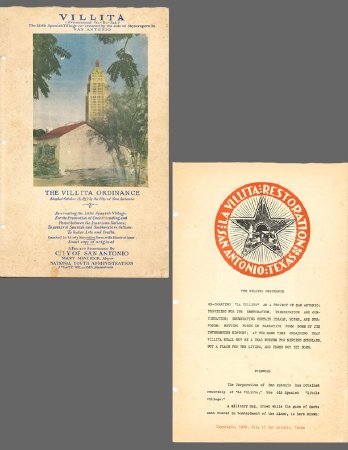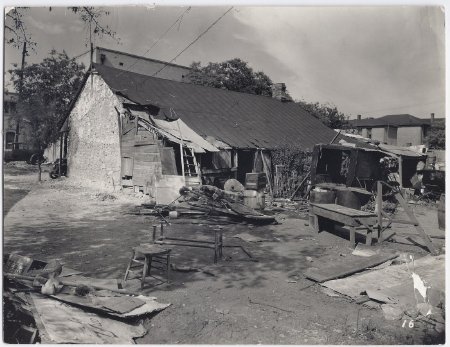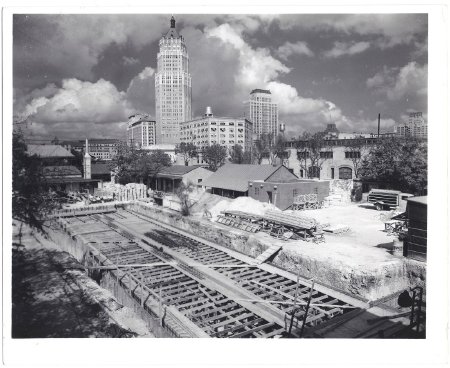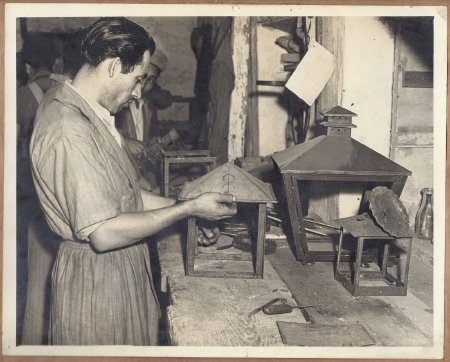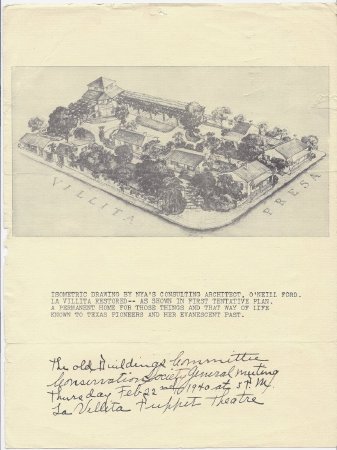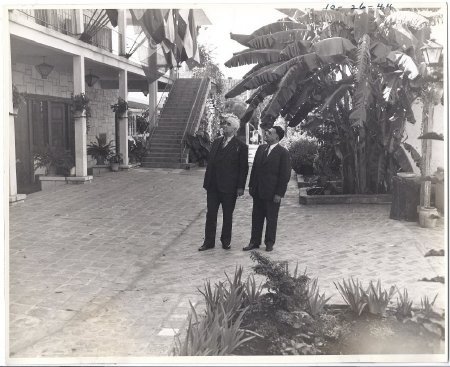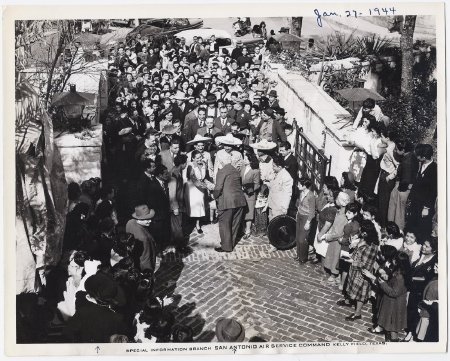La Villita
History:
Of all the projects Maury Maverick undertook during his term as mayor (1939-1941), the restoration of historic La Villita became one of his proudest achievements.35
The Spanish had established a small village east of the San Antonio River, near the Alamo, in 1722. Rebuilt as a permanent settlement in 1819, it later drew European and Mexican immigrants, and became known as "La Villita." By the 1930s, the neighborhood was neglected, overgrown, and filled with garbage, but the crumbling houses still stood. La Villita's ties to the city's Spanish and Mexican heritage, embodied in its surviving architecture, made it the perfect site to restore as a center for Pan American culture and crafts.36
As early as 1935, the San Antonio Conservation Society had voiced its interest in restoring picturesque Villita Street. Society members felt that it could become a public attraction, like the recently restored Olvera Street in Los Angeles, which recreated that city's historic Mexican marketplace.37 Maverick's election in 1939 led to the realization of their desire. Maverick used his connections in the U.S. Congress, and with President Roosevelt, to get funding for La Villita as part of a New Deal project headed by the National Youth Administration (NYA). As a result, the restoration of the little village helped to create local jobs, which taught skills in tile making and metalworking.38
Maverick frequently brought notable visitors to admire La Villita, insisting that work in progress had to be finished on short notice for his guests. These demands fell on a young architect named O'Neil Ford, whom Maverick had hired out of Dallas to supervise the site restoration. Ford's conflict with the mayor over this issue cost Ford his job, but ultimately launched his architectural career in San Antonio.39 When completed in 1941, La Villita served Maverick as "a backdrop for conferences, speeches, and other important occasions pertinent to Pan-American relations."40
The Spanish had established a small village east of the San Antonio River, near the Alamo, in 1722. Rebuilt as a permanent settlement in 1819, it later drew European and Mexican immigrants, and became known as "La Villita." By the 1930s, the neighborhood was neglected, overgrown, and filled with garbage, but the crumbling houses still stood. La Villita's ties to the city's Spanish and Mexican heritage, embodied in its surviving architecture, made it the perfect site to restore as a center for Pan American culture and crafts.36
As early as 1935, the San Antonio Conservation Society had voiced its interest in restoring picturesque Villita Street. Society members felt that it could become a public attraction, like the recently restored Olvera Street in Los Angeles, which recreated that city's historic Mexican marketplace.37 Maverick's election in 1939 led to the realization of their desire. Maverick used his connections in the U.S. Congress, and with President Roosevelt, to get funding for La Villita as part of a New Deal project headed by the National Youth Administration (NYA). As a result, the restoration of the little village helped to create local jobs, which taught skills in tile making and metalworking.38
Maverick frequently brought notable visitors to admire La Villita, insisting that work in progress had to be finished on short notice for his guests. These demands fell on a young architect named O'Neil Ford, whom Maverick had hired out of Dallas to supervise the site restoration. Ford's conflict with the mayor over this issue cost Ford his job, but ultimately launched his architectural career in San Antonio.39 When completed in 1941, La Villita served Maverick as "a backdrop for conferences, speeches, and other important occasions pertinent to Pan-American relations."40
About this Image:
1) The cover and first page of the Villita Ordinance booklet, which features the La Villita seal and mission statement. Many restored structures were named after significant Latin-American heroes and liberators, reflecting the patriotic Pan American themes dear to Mayor Maverick's heart. Streets and plazas bore the names of Mexican heroes, such as Miguel Hidalgo and Benito Juarez. Also check out the SPANISH VERSION of the Ordinance. Credit: City of San Antonio, Copyrighted 1939.
2) La Villita before restoration, showing the rear of San Martin House, named for José de San Martín, leader of Argentina's war for independence, at 104 Hidalgo Walk. Notice the dilapidated condition of the house, as well as the junk scattered in the yard.
3) The foundation for Bolivar Hall, one of the few new additions to the old neighborhood, is being laid at center. It honored Simón Bolívar, who helped to secure Venezuela's independence from Spain. During the war, the Red Cross trained civilians here. The two houses to the right of it are the Caxias House, honoring the Duque de Caxias, a Brazilian patriot, and the San Martin House, right.
4) This image comes from Ethel Harris' scrapbook, and shows a man creating pressed metal and glass lanterns, which in addition to tile making, was one of the skills taught to workers. Harris who was a Society member, served as the technical supervisor of the Arts and Crafts division of the WPA in San Antonio in 1939.41
5) Letter to Mrs. R. L. Dalton. The main image is an isometric drawing by O'Neil Ford, detailing the layout of La Villita.
6) La Villita provided a special setting for hosting visiting dignitaries. Here, Commissioner Preston L. Anderson stands with Mexican Consul General Carlos Calderon, looking up at the completed Bolivar Hall.
7) As acting Mayor P.L. Anderson (with back turned), welcomes Cantinflas and actresses Elmira Rios and Esther Fernandez (left to right) to La Villita. The man with glasses standing behind two men in sombreros is Jimmie Lederer, a cameraman for various film companies. A crowd packs the walkway behind visitors, with more onlookers lining the walls.
2) La Villita before restoration, showing the rear of San Martin House, named for José de San Martín, leader of Argentina's war for independence, at 104 Hidalgo Walk. Notice the dilapidated condition of the house, as well as the junk scattered in the yard.
3) The foundation for Bolivar Hall, one of the few new additions to the old neighborhood, is being laid at center. It honored Simón Bolívar, who helped to secure Venezuela's independence from Spain. During the war, the Red Cross trained civilians here. The two houses to the right of it are the Caxias House, honoring the Duque de Caxias, a Brazilian patriot, and the San Martin House, right.
4) This image comes from Ethel Harris' scrapbook, and shows a man creating pressed metal and glass lanterns, which in addition to tile making, was one of the skills taught to workers. Harris who was a Society member, served as the technical supervisor of the Arts and Crafts division of the WPA in San Antonio in 1939.41
5) Letter to Mrs. R. L. Dalton. The main image is an isometric drawing by O'Neil Ford, detailing the layout of La Villita.
6) La Villita provided a special setting for hosting visiting dignitaries. Here, Commissioner Preston L. Anderson stands with Mexican Consul General Carlos Calderon, looking up at the completed Bolivar Hall.
7) As acting Mayor P.L. Anderson (with back turned), welcomes Cantinflas and actresses Elmira Rios and Esther Fernandez (left to right) to La Villita. The man with glasses standing behind two men in sombreros is Jimmie Lederer, a cameraman for various film companies. A crowd packs the walkway behind visitors, with more onlookers lining the walls.
To Learn More:
View Catalog Record (Main Image)
View Catalog Record (Image 3)
View Catalog Record (Image 6)
View Catalog Record (Image 7)
View Catalog Record (Image 3)
View Catalog Record (Image 6)
View Catalog Record (Image 7)
Credit:
Courtesy of San Antonio Conservation Society Foundation.

